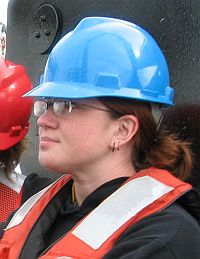
Whitney |
Whitney Sauve
Baccalaureate Candidate
Department of Civil & Environmental Engineering
Michigan Technological University |
For those seven days, where the sky met the water both of them
radiant blue
We slept, we ate, we laughed, we grumbled, we smiled
And were reduced at sunset to tiny organisms
In reverence of the blazing red horizon
Above silky pink ripples of sea
During mornings and afternoons
We would gather at the back of the boat all hardhats, lifejackets,
steel-toe boots
We watched, we listened, we sampled, we separated
And bore witness to the time between now and the glaciers
Rubbed its fine particles between our fingertips
Staying up through the night to sample, to drain, to separate
To befriend the sculpin and diporeia
Somewhere between the divine moonrise
And categorizing a species according to size I found myself truly
present
In the water’s reflection, the instruments, the company
My spirit stretched taut and it was only Me, The Journey And the
Sea
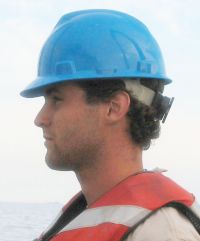
Kyle |
Kyle Bareither
Baccalaureate Candidate
Department of Civil & Environmental Engineering
Michigan Technological University |
In my experience on the Lake guardian I realized how much I
loved the outdoors. When I was out on the lake all my responsibilities
faded away with the quickly disappearing land. All there was left
was the knowledge to be attained from the lake with the careful
guidance of our instructors. This boat became like a family and
we relied on one another and did what was needed to get the research
done while gaining an understanding of a great natural resource,
Lake Superior. My “fish,” was everyone, teachers and
students, participating as one to help understand our resources
for future generations.
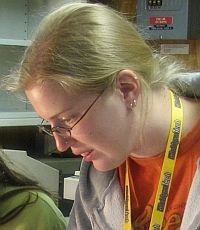
Carly |
Carly Bock
M.S. Candidate
Department of Civil & Environmental Engineering
Michigan Technological University |
At the beginning of the cruise, we were all asked to “find
our fish.” This kind of made me nervous at first. What if
I can’t find anything interesting enough to me to call it
my “fish”? Well, I had nothing to worry about. I didn’t
recognize it at first, because the experience was so overwhelming.
But after a few days I began to realize that my fish was everywhere.
From the sediments (which is where my research is anyway) to the
benthos to the plankton to the fish, including the temperature profiles
and light attenuation, I was fascinated. If I had to pick one subject,
though, it would be the chemistry. I’ve always loved chemistry,
and seeing it applied to environmental systems was the icing on
the cake. Even the less scientific/more romantic aspects were captivating.
Spectacular sunsets (and moonrises!), scenic coastlines, crystal
blue water… On the first day we had rough weather, and despite
my seasickness, I couldn’t help but sit by the door and watch
the waves crash over the back deck. All in all, this trip has inspired
a desire to remain on the shores of Lake Superior for the rest of
my life, so I guess you could say I “found my fish”
in the lake itself.
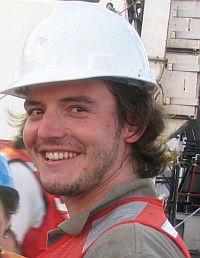
Maxime
|
Maxime Bridoux
Ph.D. Candidate
Department of Environmental Chemistry
State University of New York - Albany
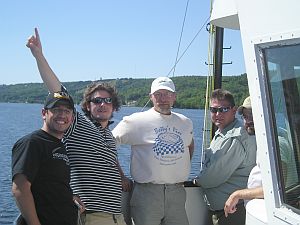 |
I really enjoyed being part of the “Ecology of lake Superior”
(or “the quest for Diporeia”…) course aboard the
lake Guardian this summer. This trip gave each of us the opportunity
to be involved in the assessment of Lake Superior lower food-web.
Part of this assessment included sampling phytoplankton, zooplankton,
sediments cores, benthic organisms… Of these many different
activities, the collection and taxonomic identification of the phytoplankton
(the base of the whole food web) was my favorite activity, especially
the fact that we were sampling and identifying from the boat, microscopic
organisms that represent the primary food and energy source (the
“fuel”) of this ecosystem; meanwhile a satellite was
gathering data of reflected light by the lake’s surface water,
which ultimately will allow scientists to estimate the productivity
of the lake. This contrast between the micro- and the macroscopic
was really fascinating to me.

Sharon |
Sharon Heineman
Biology, Chemistry Teacher
Culver Academies
Culver, Indiana |
I actually rediscovered one “fish” and found a
new one during my week aboard the Lake Guardian. The rediscovered
“fish” was the satisfaction one finds when questions
are answered through the process of collecting and analyzing data.
While, I wasn’t in on the actual design of the project, I
thoroughly enjoyed the collection (and problem solving) and preservation
of samples. With experience with only land dwelling organisms (deer,
quail, plants, etc.), I learned much about the additional requirements
necessary when collecting from the depths of an aquatic environment.
The second fish was the hidden world of plankton. It is almost
unimaginable to think what goes on in a world that is invisible
to us under normal conditions. The collection, identification and
information made while checking our IDs really made me more appreciative
of this hidden world which is actually the very basis of life in
the lake. I want to take some extra time with my students next year
to try to lead them to appreciate this microcosm as I do.
It was also good to have an opportunity to hear from leaders
in various areas of research and find out what the very newest ideas
are concerning ecology. I like to bring up these new ideas when
the old ones show up in the readings we use in class.
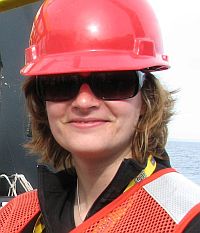
Lisa |
Lisa Hoogenboom
Chemistry Teacher
Maine South High School
Park Ridge, Illinois |
Today we dissected fish on the upper deck of the boat. While
cutting open fish guts reminded me why I wouldn’t make it
as a biology teacher, it was interesting to see what my colleagues
pulled out of their fish stomachs. One was a fish almost as long
as the lake trout, with an undigested, sharp fin. This caused me
to think about the fact that the bigger fish eat the littler fish,
eat the littler fish, eat the zooplankton, eat the phytoplankton….and
that a lot of atoms in that fish came from the smaller organisms
that either it ate directly or from something that the fish before
ate. Fish scales can apparently be used to determine the age of
the fish. I took a couple fish scales off of one of the lake trout
and brought it down to the microscope. The fish had between sixteen
and twenty-five rings, depending on how you counted. This caused
me to think about how this fish was at least as old as my high school
students and had been swimming around for as long as they’ve
been alive.
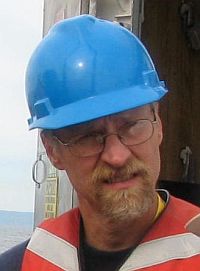
Robert |
Bob Kaukola
Math, Science Teacher
GFW Middle School
Fairfax, Minnesota |
My fish was found by all the ideas I received for my 7th grade
science class. I can incorporate things such as plankton sampling
and sediment sampling to help my students understand the ecology
of the local lake. We can then compare it to the ecology of the
local stream and discuss the impact of the land practices on the
ecology of the water. I can then incorporate the chemical analysis
of certain farm fertilizers, pesticides, and herbicides and hopefully
tie this into a big picture so that students may see the connectedness
of all these ecosystems.
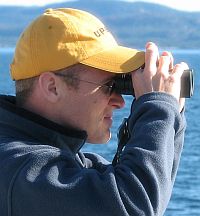
Scott |
Scott Martin
Life Sciences Teacher
American School of Japan |
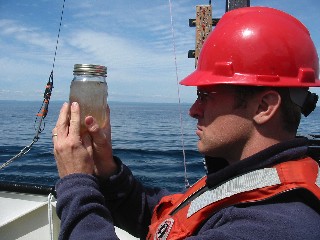 |
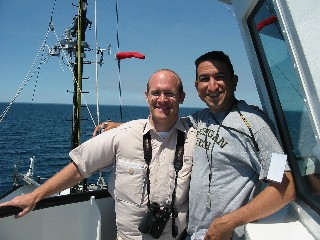 |
I have many pleasant memories of the week that I spent sailing
the waters of Lake Superior on the R/V Lake Guardian. The ship was
the venue for the Ecology of Lake Superior class and all of our
coursework took place on the boat over the week of July 8th, 2006.
Highlights of the trip include the following; sifting through 4
degree (C) bottom sediment at 3 AM in search of Diporeia, watching
8 foot waves give way to progressively smaller waves and feeling
my appetite return and talking world politics with my new friend,
Ziad. I enjoyed the chance to get my hands dirty while processing
PONAR on the fantail and getting to know the diverse group of students
and instructors while working. I choose to spend my free time on
the upper decks where I could view the ever changing panorama of
Lake Superior passing by and absorb of tales told by the crew members.
All in all the class was an experience like none other and I look
forward to sharing illustrations from the trip in my classroom.

Anne Marie |
Ann Marie Miller
Explorer
Marquette, Michigan
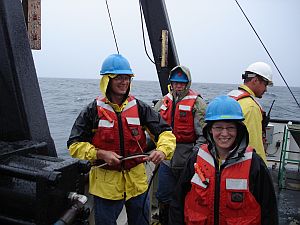 |
Optics in the Rain/Secchi Disk at Night.this group has spunk!
It didn't take long to find my fish. The researchers from Upstate
Freshwater Institute were collecting data enthusiastically. It was
raining, cold, and the waves were making an appearance. Time was
an issue and final preparations for the Hyper Pro were being made
by Dr. Alan W. He turned to me and said, "I'm going to throw
it in and see what happens." As I watched I thought there she
goes, that's my fish, that's me."
P.S. Thank you to all the generous spirits, faculty/participants/crew,
aboard the R/V Lake Guardian who shared their knowledge, talents
and time for a most enjoyable adventure.
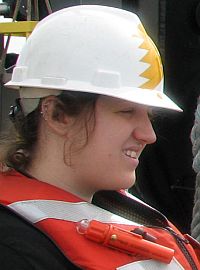
Ashley |
Ashley Parks
M.S. Candidate
Department of Civil & Environmental Engineering
University of North Carolina |
Ashley Parks
M.S. Candidate
Department of Civil & Environmental Engineering
University of North Carolina
Journal Entry from July 12th, 2006: We're supposed to finding
our "fish" while we're here. I was pretty sure before
I came on the boat that my fish would be modeling. Modeling now,
on the boat, is more fun than normal modeling. I'm completely taken
away from everything except the water. No daily life chores or expectations.
I love the engulfment of being the on boat-- it makes the modeling
more real. Even though I'm working on a computer, everything I'm
modeling is surrounding me.
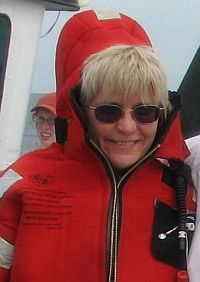
Anita Quinn |
Anita Quinn
Director
Research and Sponsored Programs
Michigan Technological University |
What type of fish did I "catch' on this trip? Certainly
an opportunity to take the time to think about how "awesome"
God's creation is. He not only takes care of the birds in the air,
but the fish in the sea (including beautiful fish like the Sturgeon),
and every other creature too. He certainly has done a good job of
taking care of me. He's got it down, right to Zooplankton and Phytoplankton.
There are few areas of study that I feel provide me with an
opportunity to get down to my core values, rethink them, and not
only grow my knowledge, but my spirit too. Biology, Geology, Forestry,
and Civil & Environmental Engineering are certainly disciplines
I enjoy and provide me with this opportunity. Watching the enthusiasm
and interest of the students was very inspiring and I appreciated
the chance provided to interact with them.

Paul |
Paul Rogalla
Life Sciences Teacher
Indianola Middle School
Indianola, Iowa |
The time spent on the Lake Guardian represented the most intense,
biological event I have ever experienced. Doing PONARS in Canada
under the moon at 11:00pm at night was very exciting and very gratifying.
It was a once in a life time experience, spiritual in nature. My
fish was found within the people and the research, to be part of
true research on one of our nation's pristine ecosystems, not acting
as an observer, but the opposite. Each day we were confronted with
new ideas and talented people sharing their passions. All those
aboard the research vessel were actively engaged in the research
projects which were aimed at learning about the ecosystem called
Lake Superior.
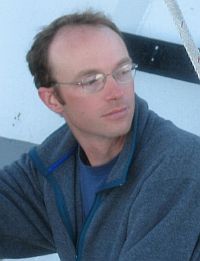
Mark |
Mark Rowe
Ph.D. Candidate
Department of Civil & Environmental Engineering
Michigan Technological University |
On July 9th around 9am, we arrived at Stannard Rock Lighthouse.
It was cool, overcast and light rain was falling. Dr. Noel Urban
pulled up a sample of sediment from the bottom using a PONAR sampler
in 170m of water. The sample had a thin layer (20 mm) of dark sediment
on the surface, with red clay below. There was also a striking band
of red and black material about 50 mm below the surface.
It was of particular interest to me to see the sediment sampling
in the course because I had written a paper on a mass balance model
for polybrominated diphenyl ethers (PBDEs) in Lake Superior. PBDEs
are used as flame retardants in many consumer products and are being
implicated as persistent bioaccumulating toxicants (PBTs). Burial
in the sediment is an important removal mechanism for these hydrophobic
chemicals from the water column. I had compared my model results
to PBDE concentrations in dated sediment cores from another research
group. The sediment core data showed very interesting trends in
burial rates of PBTs with respect to time that followed production
and use rates of the chemicals over the past 50 to 100 years. Of
particular interest in the sediment samples that I saw on the course
was the dark layer of sediment that had been deposited in the post-glacial
period over the last 4000 years. This layer, which would contain
all of the anthropogenic PBTs, was easy to discern from the thick
underlying layer of gray or red clays that were deposited during
the period when the continental glaciers were melting. The post
glacial sediment layer was very thin, only about 20 mm in most samples.
I could better appreciate that it must be a challenging process
to slice that layer into thin samples representing approximate ten
year periods for PBT and dating analysis.
In contrast to many lakes, the sediments of Lake Superior are
oxic to a substantial depth because of the low temperatures and
low biological activity. This is actually visible in the sediment
samples because a layer of red iron and black manganese oxides precipitates
about 50 mm below the surface at the interface between the oxic
surface layers and anoxic deeper layers.
A final observation of interest came from the ROV dives. Most of
the PBTs that settle to the sediment-water interface are not buried,
but re-suspended into the water column. This process is not well
described by equilibrium partitioning models in Lake Superior, suggesting
a more complex phenomenon. With the ROV, it was possible to see
what was going on at the sediment-water interface. There was a surprising
amount of biological activity in the form of zooplankton. It was
also surprising to see currents at each of the ROV dive locations;
there was much more activity at the sediment-water interface than
I would have anticipated.
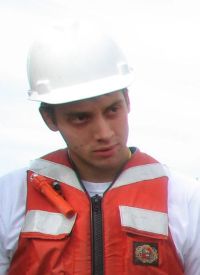
Carl S |
Carl Schroeder
Baccalaureate Candidate
Department of Civil & Environmental Engineering
Michigan Technological University
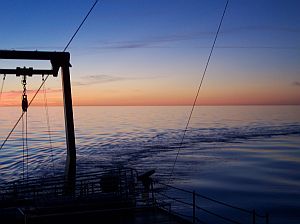 |
Being afloat on Lake Superior for seven days offers a unique
opportunity to evaluate your life and attempt to focus in on what
you feel is your place, purpose, and calling during our time on
this planet. Given this, I found that my “fish” was
the entire experience and how it allowed me to realize my after
graduation desires. Having the opportunity to gaze off into the
limitless horizon of Lake Superior, without any physical obstructions,
allows ones mind to clear and engage in deep thought. Also, daily
occurrences such as the orange and pink hue of the setting sun erupting
behind the rugged Canadian coast, splashing its color across the
smooth ripples of the lake, only to be replaced by the yellow streak
of the rising moon, proved complementary to that state of mind.
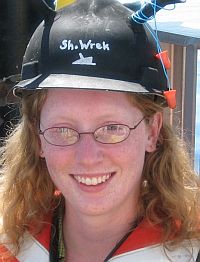
Lisa |
Lisa Tomlinson
M.S. Candidate
Department of Civil & Environmental Engineering
Michigan Technological University |
The most thrilling part of the Lake Guardian experience was
to be out on the big lake itself, doing field work. The (seemingly)
endless ponar sampling, the excitement of pulling up a benthic sled,
and the subsequent hours of sample processing in the lab were completely
exhausting. The absolute immersion in the benthic fauna of the lake,
the camaraderie of a late night lab group, and the surprise of a
sculpin in a ponar jar made you forget your exhaustion, and instead
allowed you to be swept away in the marvelous world that is Lake
Superior.
|

